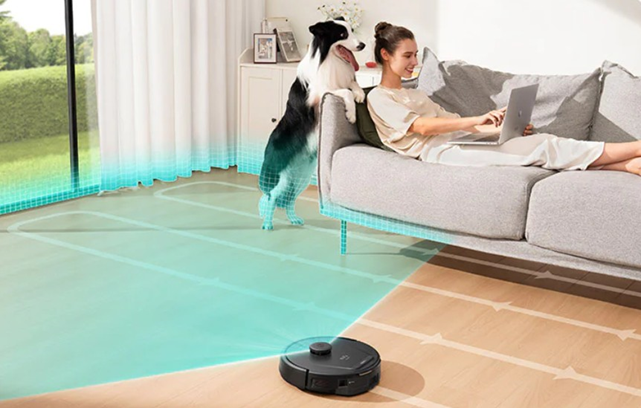A robot vacuum cleaner is more than just a trendy gadget; it saves time and cleans efficiently. With so many models, prices vary widely, making shoppers confused about which features are necessary. Understanding how smart cleaners function allows consumers to avoid overpaying for items they do not need. This article examines what justifies a higher price and offers purchasing advice to optimize value. Knowing what to look for might help first-time and upgrade purchasers make smarter decisions.

What Features Justify the Cost of a Robot Vacuum?
Smart Navigation and Mapping Capabilities
High-end robot vacuums do not travel aimlessly; they map out your home to clean effectively. These devices use laser-guided sensors, cameras, or LiDAR to generate smart maps and track cleared areas. This feature enables zone cleaning, room-specific scheduling, and improved obstacle avoidance. Instead of bouncing off obstacles, they choose rational courses, covering more land in less time. This leads to decreased energy use and wear and tear. Furthermore, these smart maps frequently allow for virtual borders, ensuring that the robot vacuum cleaner avoids locations such as pet bowls or cables. This amount of cognitive navigation is a significant element in increased cost.
Suction Power and Multi-Surface Cleaning
Strong suction is essential for effective cleaning. Premium robot vacuums frequently include adjustable suction settings, allowing them to clean carpets, hardwood, and tile without the need for manual adjustments. These machines recognize surface types automatically and increase suction for more thorough carpet cleaning. Cheaper versions may struggle with pet hair and big debris, particularly on rugs. Higher-end models also have rubberized brushes and improved filtration systems that better manage allergens. If your family has dogs or children, this update will pay dividends in the long term. Some robot vacuum cleaner models are more expensive due to their ability to perform across numerous floor types without the need for operator intervention.
Battery Life and Auto-Recharge Functions
Longer battery life implies more distance traveled in a single run. Premium robot vacuums can clean for 90 to 180 minutes on a single battery, which is plenty for big houses or several rooms. More astounding is their capacity to return to their dock, recharge, and continue cleaning autonomously. This is great for busy homes where interruptions would normally necessitate manual resets. Lower-end models may stop in the middle of the cleaning process and must be restarted manually. These seamless features save time and limit your participation. They also limit the likelihood of missing areas, resulting in a consistently clean environment. For those who value convenience, the battery and auto-recharge options make the cost worthwhile.

Key Buying Considerations to Maximize Value
Maintenance Costs and Replacement Parts
Purchasing a robot vacuum cleaner is only the beginning; upkeep is critical to long-term value. Filters, side brushes, rollers, and batteries all need to be replaced eventually. Premium brands frequently allow simple access to components and provide extras in the packaging. Cheaper choices, on the other hand, may save money in the short term but cause problems later on when parts are difficult to obtain or prohibitively expensive. Consider the usual replacement cycle: filters every 1-3 months and brushes every 6-12 months. Some vacuums also require frequent software upgrades to function properly. Before making a purchase, check part availability and cost. Brands that provide subscription programs or bundles for consumables can assist in minimizing future costs and simplify maintenance over time.
App Features, Voice Control, and Smart Home Integration
Many current robot vacuums contain companion applications that go beyond the start button. Look for models that allow you to schedule, establish no-go zones, and track cleaning history using your phone. Alexa and Google Assistant connectivity provide hands-free operation. Some advanced vacuums are compatible with smart thermostats and lighting for home automation. Certain applications lack functionality or connection. A premium robot vacuum cleaner should include a well-designed app and smooth integration with your existing smart home setup. This seamless control enhances user experience, providing better flexibility and customization than budget-friendly alternatives can match.
Brand Reputation and Warranty Coverage
Branding is vital for robotic vacuums. Established companies often provide superior performance, customer service, and software upgrades. Look for companies with a proven track record, positive client feedback, and fast help. The standard warranty period is one year. However, some top manufacturers provide extended protection or satisfaction guarantees. This suggests the product’s durability. Before making a purchase, look for clear warranty restrictions and easy claims. Check the company’s trial period or money-back guarantee. Spending more on a respected brand eliminates defects, ensures long-term support, and makes your robot vacuum cleaner investment feel justified.
Conclusion
Paying more for a robot vacuum cleaner provides long-term convenience, dependability, and performance, not just showy embellishments. Smart navigation, strong suction, and a long battery life make it possible to clean your home easily. App control, warranty coverage, and affordable maintenance all contribute to value. Buyers may avoid gimmicks and focus on true benefits by understanding price determinants. Select the ideal model for your space and lifestyle to ensure long-term satisfaction. A robot vacuum cleaner has the potential to alter your home if designed properly.
Visited 1 times, 1 visit(s) today


